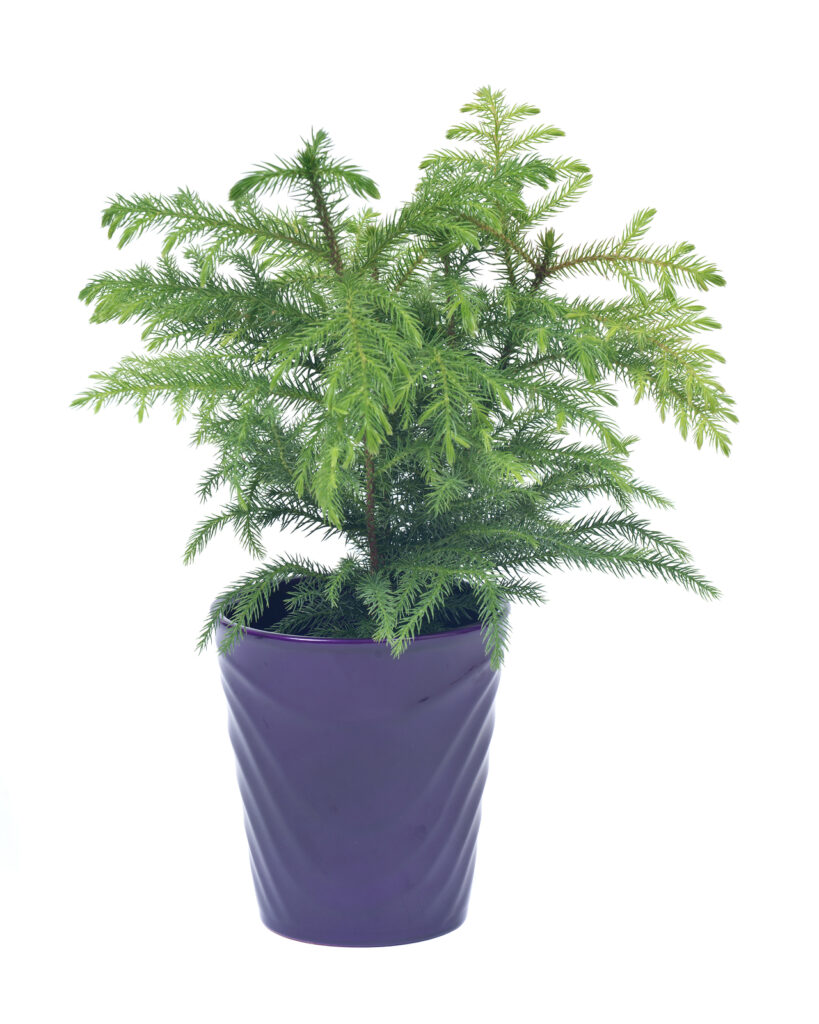Araucaria–commonly called Norfolk Island Pine–is a graceful, pyramidal, tiered tree that can be grown indoors and out. Araucaria is an evergreen; the branches are covered with needles that may be stiff or soft, and flat or rounded.
Araucaria are members of the Pine Family, natives of the South Temperate zone. There are about 18 species in the genus. They are much planted as ornamental specimens in the South and California. They are deservedly popular in juvenile form as house plants.
As house plants, Araucaria are usually bought in florists but they can be propagated from cuttings, seed, or by stem-rooting in a cool greenhouse. They will not endure crowding or exposure to burning sunlight.
Get to know Araucaria
- Plant type: Evergreen needled tree
- Growing Zones and range: Zones 10-11
- Hardiness: Cool, moist frost-free conditions; a range of temperature from 45°-85°F
- Opotimal growing temperature: Ideal conditions are 70°F (21°C) during the day, 50°-55°F (10°-13°C) at night
- Height and width: Norfolk Island pine grows up to 5’ tall indoors and in containers; up to 100’ outdoors
- Foliage: Tiered branches with bright green, soft needles; branches have resinous sap
- Uses: Specimen plant in mid-winter climate
- Common name: Norfolk Island Pine
- Botanical name: Araucaria heterophylla
- Family name: Araucariaceae
- Origin: New Guinea, Australia, New Heberdies, New Calidonis, Norfolk Island
Where to plant Araucaria
- Grow Araucaria outdoors in moderately fertile, moist, but well-drained soil.
- Plant Araucaria in full sun in an open but protected site.
- Keep the soil evenly moist.
- Indoor light: medium-light; bright light as long as temperatures are cool

Planting and spacing Araucaria
How to water and feed Araucaria
- Keep Araucaria the soil evenly moist.
- Fertilize Araucaria two to four times a year.
Araucaria care
- Araucaria naturally loses lower branches, so trim them out as they begin to die.
- Taking cutting will ruin the shape of your plant.
Growing Araucaria as a houseplant
- Araucaria heterophylla often grown as a houseplant; commonly grows to 6 feet tall indoors.
- Araucaria grows best in bright light and average to cool room temperature with good air circulation. Needs medium humidity; low humidity will cause needles to brown.
- Water thoroughly and allow the soil to dry to the touch before watering again.
- Apply fertilizr in spring and summer.
- Turn the pot frequently to maintain even growth.
- Grow Araucaria in African violet mix. Repot about every 3 years when the roots grow to big for the pot.
Araucaria pests and diseases
- Araucaria is prone to attack by mealybugs and scale insects.
- Needle necrosis and bleeding canker and occur.
Araucaria propagation
- Sow seed in a seedbed as soon as ripe.
- Take cuttings 3 to 4 inches long of vertical shoot tips in midsummer and root in a cold frame; cuttings of the horizontal side branches will never form an erect tree.
- Home progagation can be difficult.
Araucaria varieties to grow
- Araucaria araucana, monkey puzzle. Coniferous tree with whole branches, conical when young become round with age; loses lower branches when old; radially arranged, leathery bright green leaves are sharply pointed. Grows 50 to 80 feet (15-25m) tall and 22 to 30 feet (7-10m) wide.
- A. bidwillii, bunya-bunya. Similar habit as A. araucana; grows 100 to 150 feet (30-45m) tall and 20-30 feet (6-10m) wide.
- A. columnaris, Cook pine. Conical to columnar tree grows 100 to 160 feet (30-50m) tall and 10 to 20 feet (3-6m) wide; lateral branches are soon lost and replaced by short shoot producing a narrow column of foliage.
- A. heterophylla, Norfolk Island pine. Conical coniferous tree with whorled branches of fan-like foliage; young trees have narrowly wedge-shaped leaves; grows 80 to 150 feet (25-45m) tall and 20 to 25 feet (6-8m) wide.















